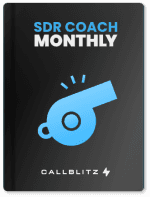Top 4 Methods for Cold Call Coaching with a Remote SDR Team

Jack Knight
Jul 2, 2022
TL;DR:
The shift to remote work has revolutionized the way business is run on a global scale. And although remote work has brought a lot of flexibility and freedom for many companies, it has been hard for remote sales teams.
The biggest downside, particularly for sales teams, is that we aren't rubbing elbows with our team on a daily basis. The knowledge exchange and community building that happens when humans are with other humans in person is beautiful. But this is not the case for sales teams anymore.
Remote teams have to overcome hurdles like delayed feedback loops, infrequent (and inorganic) opportunities for knowledge transfer, and the fact that any human interaction they have is through a computer screen.
Sales managers can try to find ways to coach their reps in a remote setting, and some of the strategies they can explore include the use of mock calls and call recordings, baptism by fire, which is about learning through doing the job, and implementing real-time call coaching.
The shift to remote work has revolutionized the way business is run on a global scale.
Upwork’s Future Workforce Report predicts that 73% of all teams will feature a level of remote work by 2028.
Tech was trailblazing the future of remote work long before COVID was even a thought. At this point, remote work flexibility is a tech industry standard, and companies are required to offer, at minimum, a hybrid option to stay competitive.
As much as remote work has benefitted employees, their families, and society as a whole, we'd be foolish to ignore the obvious downsides that come with work-from-home (WFH) situations, especially for those in the sales world.
The biggest downside, particularly for sales teams, is that we aren't rubbing elbows with our team on a daily basis. The knowledge exchange and community building that happens when humans are with other humans in person is beautiful.
It's live, it's organic, and it doesn't stop until 5 o'clock rolls around and everyone starts heading home.
All roles of all kinds require regular hands-on support, opportunities to share best practices, and an engaging community where teammates know they are not alone.
Remote teams have to overcome hurdles like delayed feedback loops, infrequent (and inorganic) opportunities for knowledge transfer, and the fact that any human interaction they have is through a computer screen.
Now, multiply this difficulty by x10 and add in the element of cold calling...welcome to the struggle of remote sales development coaching!
So, how can SDR Managers train and coach their team effectively on cold calling, while giving them the many benefits that come with a WFH environment?
Let's get into our options...
Mock Calls
Mock calling is when a manager or peer jumps on with a rep and runs them through common scenarios they will encounter when speaking to prospects.
These scenarios typically involve handling wild objections, obnoxious prospects, and answering detailed product questions.
Mock calls are perfect for getting a rep started in a new role or polishing up a tenured rep's skills. These scenarios help reps understand the general flow of a cold call, get them used to thinking on their feet and using proper terminology, and are overall a great way to get them exposed to cold calling.
So, what's the problem?
Most mock call scenarios are hyperbolic and extreme.
Prospects in real life are generally not rude, and certainly not well-versed enough in your product to ask the kinds of questions included in those scenarios. In fact, most B2B prospects, especially in SaaS, are incredibly welcoming! So this is more of a scare tactic than it is based on reality.
Post-mock call feedback is incredibly biased.
Most reps will be overly kind to their teammates, providing fluffy, unhelpful feedback. If reps haven't learned how to give constructive feedback, mock call sessions will be unfruitful.
Mock call training is resource-heavy.
Having reps spend 30 minutes together going back and forth over a mock call might not be the best investment in time, especially if a manager is there to help out. That is two sales reps that could have knocked out 30 calls each within a 30-minute call block. They would have had at least 2-3 real conversations with real prospects navigating real scenarios. And if they do their call block together, they can still coach and give feedback on improvement areas.
That said, mock calls are an incredibly valuable tool and an important piece of the coaching puzzle. That is if you avoid the pitfalls above.
Plus, the future of mock calls is bright, especially with AI-powered tools like SecondNature.ai leading the way by providing realistic mock scenarios accompanied by structured training modules for reps to complete as part of their required onboarding and continued development.

Call Recording Analysis
Recording calls and analyzing them afterward is a tried and true approach to effective coaching.
Hindsight is 20/20, and when managers can walk their reps through their very own calls, the reps tend to have a lot of insight and self-feedback into what they said, why they said it, and how they communicated it.
This gives reps the opportunity to develop their own coaching muscles so they can be more independent as they grow in self-awareness and self-correction.
Another benefit of using call recordings is the ability to assemble a "win library" full of your team's top calls, codifying best practices and tribal knowledge into a singular database for new hires to reference as they learn the ropes.
Conversely, a "fail library" is a great way for new hires to learn what not to do, and also be exposed to the reality of cold calls - sometimes, no matter how good you are on the phones, you mess up, and that's okay!
Post-call coaching has become an industry in itself, with AI-based technologies like Gong, Chorus, and our favorite, ExecVision, 90% of the coaching is done for you.
These technologies transcribe conversations to highlight positive and negative trends, such as talk-time, active listening, and objection handling, allowing reps and managers alike to score their performance on actual data.
So, where does coaching via call recordings fall short?
These tools are not designed for SDR teams, they are generally optimized for Account Executives (AE) facilitating demos and discovery calls. Outbound cold calling is certainly supported, but it is not the primary use case.
It is time-consuming for both the manager and the rep. For an AE and AE Manager, there are only a handful of calls to review each week, granted, these calls are longer in length compared to a cold call, but, for an SDR and SDR Manager, the SDR should have 10-20 conversations a week (roughly 3-5% connect rate on 80 dials/day). There is no way an SDR Manager can review 10-20 conversations, times the number of reps they have, every week, with quality. It is simply too much ground to cover for one manager.
Proficiency with cold calling comes through repetition (10,000 hours, right?). Coaching cold calls via call recordings is always after the call. It is easy to nitpick a cold call and talk about theories and what a rep should have done, but in all likelihood, the rep being coached is only going to remember one thing from the coaching session, and, hopefully, apply it to their next call, whenever that happens to be. There is no warranty on getting the coaching to stick, you are just hoping they follow through.
Again, call recordings play a crucial role in rep development, especially when reps become more experienced and are fine-tuning their pitches and value props later on.
But to rely on post-call coaching alone is an ineffective coaching plan, and the reactive feedback without repetition is going to be out of sight and out of mind for your reps as they embark on their next solo dialing adventure.
This brings us to our last option...baptism by fire.
Baptism by Fire
We are all familiar with it; on-the-job training (OJT), sink or swim, learning by experience. Baptism by fire is the default training program for most companies of all industries that don't have dedicated resources to train and invest in their reps.
But you, as a responsible sales manager/eager sales rep, scoff at the idea of not having a structured, well-supported training program, because you know how silly it would be to skip over this.
At the same time, the best learning we can do is OJT. There is no quicker way to ramp or better way to learn than by diving in headfirst. But, just like the other options above, to rely on baptism by fire alone would be a foolish choice.
Why not throw reps into the fire?
Constant feedback and coaching are a must. Throwing reps into the fire might sound like an effective way to train them, but without their manager's support and advice, it won't be long before they run out of ambition and sputter out. Defeat turns into self-doubt, which turns into hopelessness, which turns into attrition, and we all know sales development reps (especially new hires) come with a high flight risk.
Your reps are the face of your company (hot take: it's not your CEO or anyone else in the C-Suite). They are leaving the first impression on everyone they talk to in your market, whether you realize it or not. The quality of their outreach, their conversations, and their skills, all reflect the quality of your company - make sure you are showing your best.
Lastly, managers can do better. Often as managers, we like to focus on strategy, operations, or trying to optimize our CRMs and sales engagement platforms to be more efficient. Granted, these things are crucial to a high-performing sales development team, but managers often forget one of the main reasons they were hired is to coach and train. Coaching is complex, challenging, and exhausting, especially in a remote environment but your SDR program relies on you and your ability to upskill your reps. Between attrition, underperformance, and lack of pipeline development, there is simply too much at stake to neglect the importance of coaching on a regular basis. Plus, there are plenty of tools, resources, and classes out there that basically do the coaching for managers! There is no excuse.
Real-Time Call Coaching
Real-time coaching is tricky for a remote sales team. Our options are limited by the technologies we have available to us.
Methods include managers "eavesdropping" on live cold calls via dialer technologies, jumping on a 1:1 Zoom to have a rep make dials, or, with recent advancements in technology, gathering an entire team together in one Zoom meeting to do live call blitzes and power hours together.
The obvious benefit of real-time coaching is that feedback loops are relevant, timely, and actionable for the SDR on the receiving end.
Plus, coaching is best done hands-on.
Ask any athletics coach if they would rather watch game film of their players and share written feedback with them, or if they'd prefer to be on the field with that player while they are in action.
The downside to real-time coaching is that a manager can only be with one sales rep at a time. It can be difficult for a manager to know who to listen live to and when especially when they have 8+ reps to manage.
Additionally, 1:1 coaching sessions don't allow for peer-to-peer coaching, which is arguably more effective than manager-to-rep coaching.
When sales teams were in person, everyone could gather around a table and make calls together, sharing wins, losses, and live feedback, without being disruptive or having to deal with technological limits.
Fortunately for remote sales teams, technology has caught up, and remote sales teams can re-create that in-person sales floor experience using real-time call coaching tools.
This allows for remote teams to gather on a single video meeting and run power hours together without disruption, enabling real-time coaching, live feedback loops, and the community and camaraderie that bond SDR teams and bring them closer together.
No Silver Bullets
While there is no silver bullet to remote cold call coaching, by combining the coaching methods above, you can build a scalable, sustainable, and effective coaching program, even in a remote setting.
Mock calls will expose your reps to common cold call scenarios in a safe and controlled environment, giving them the foresight and experience to handle live calls later on.
Call recording analysis will help your reps fine-tune their calling skills and also teach them how to coach themselves over time.
Baptism by fire will be the ultimate driver in your reps' development. There is no better way to learn how to cold call than to just DO.
Real-time call coaching is a must, and being remote shouldn't be an obstacle to providing reps with relevant and timely feedback.
The methods above may never directly replicate the in-person sales floor we once used to cherish so much, but with real-time call coaching software, you can blend all of the methods above to supercharge your sales coaching and turn your reps into high-performing outbound machines.
Whatever you do as you embark on your remote SDR management journey, don't stop coaching. Your team depends on it.
Ready to make your reps fall in love with the phone?
Build a real cold-calling culture on the CallBlitz salesfloor
More Here
Jack Knight
Jul 22, 2024
Why SDRs and AEs Should Dial Together
Jack Knight
Aug 22, 2024
How to Track Your Remote Sales Strategy
Jack Knight
May 8, 2024




